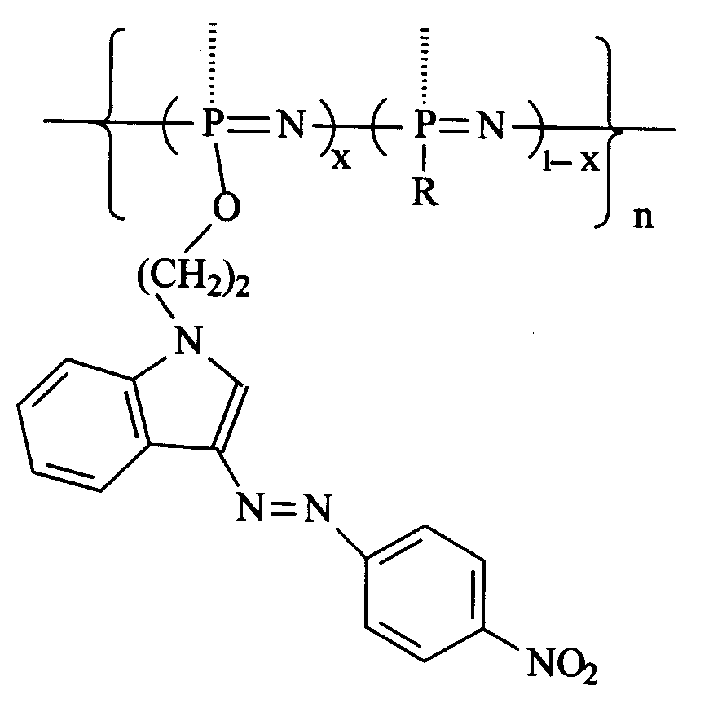Second order nonlinear optical polyphosphonitrile linked with azoineolol chromogen pendant group and its preparation and use
A second-order nonlinear polyphosphazene technology, applied in optics, optical components, instruments, etc., can solve the problems of long synthetic routes and difficult separation of small molecules, and achieve convenient purification, mild reaction conditions, and simple synthesis Effect
- Summary
- Abstract
- Description
- Claims
- Application Information
AI Technical Summary
Problems solved by technology
Method used
Image
Examples
Embodiment 1
[0013] Example 1: R is an indole group and an ethoxy group, and when x is 0.30, the synthetic route is as follows:
[0014] The synthesis method is as follows: N-(2-hydroxyethyl) indole (3) and sodium hydride are placed in a Schlenk tube, tetrahydrofuran is added, and then reacted at 50° C. for 10 hours to obtain a tetrahydrofuran solution containing compound 3 sodium salt (mass The percentage concentration is 5-8%). The above solution was then transferred to a Schlenk tube containing a tetrahydrofuran solution of the polydichlorophosphazene intermediate, and reacted at 50° C. for two days. After cooling down to room temperature, a solution of sodium ethoxide in tetrahydrofuran was added, and the reaction was continued to stir at 50° C. for four days. The resulting mixture was pumped to remove most of the THF, poured into water and allowed to stand overnight. Filter to collect light yellow precipitate, wash with water several times, and dry. Dissolve in tetrahydrofuran ag...
Embodiment 2
[0017] R is a carbazole group, an indole group and an ethoxy group, and when x is 0.10, the synthetic route is as follows:
[0018] The synthesis method is: polyphosphazene 1 can be prepared by reacting N-(2-hydroxyethyl)indole, N-(2-hydroxyethyl)carbazole and sodium ethoxide with polydichlorophosphazene, and its preparation method can refer to The preparation method of polyphosphazene 1 in embodiment 1. Weigh 0.25 g of polyphosphazene 1, put it into a test tube, add 2 ml of N-methylpyrrolidone, stir at room temperature until the polymer is completely dissolved, and put it in an ice bath. phenyldiazonium fluoroborate, reacted under ice bath conditions for 8 hours, then added 0.3 g of anhydrous K 2 CO 3 , keep the ice bath condition, continue to stir for one hour, filter, wash the reaction test tube with tetrahydrofuran, collect the filtrate, remove the tetrahydrofuran under reduced pressure, add 40 ml of methanol, an orange-red precipitate can be obtained, filter, collect ...
PUM
 Login to View More
Login to View More Abstract
Description
Claims
Application Information
 Login to View More
Login to View More - R&D
- Intellectual Property
- Life Sciences
- Materials
- Tech Scout
- Unparalleled Data Quality
- Higher Quality Content
- 60% Fewer Hallucinations
Browse by: Latest US Patents, China's latest patents, Technical Efficacy Thesaurus, Application Domain, Technology Topic, Popular Technical Reports.
© 2025 PatSnap. All rights reserved.Legal|Privacy policy|Modern Slavery Act Transparency Statement|Sitemap|About US| Contact US: help@patsnap.com

